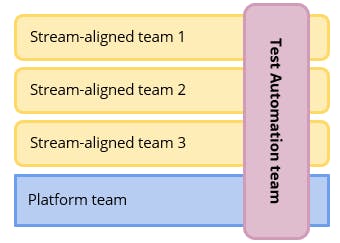
Photo by Pascal Swier on Unsplash
Enhancing Test Automation with Team Topologies: Leveraging Enabling Teams
In the fast-paced world of software development, teams are constantly seeking ways to optimize their processes and deliver high-quality products efficiently. One approach gaining traction is the implementation of team topologies, which restructures teams to better align with organizational goals and improve collaboration. In this blog post, we'll explore how leveraging enabling teams can enhance test automation within the context of team topologies.
Understanding Team Topologies
Team topologies, introduced by Matthew Skelton and Manuel Pais, provide a framework for designing effective team structures within an organization. It emphasizes the need for teams to align with the organization's architecture and business objectives. The four fundamental team types are:
Stream-aligned Team: These teams focus on delivering value directly to the customer. They are cross-functional and have all the necessary skills to deliver end-to-end solutions. Stream-aligned teams own a specific part of the business or product, enabling faster decision-making and reducing dependencies on other teams.
Enabling Team: Enabling teams provide support, tools, and platforms to streamline the work of stream-aligned teams and acting as a catalyst. They focus on creating self-service platforms, automation, and providing expertise to enable other teams to deliver efficiently.
Complicated Subsystem Team: Some parts of the system are inherently complex and require specialized knowledge. Complicated subsystem teams are responsible for maintaining and evolving these parts of the system. They collaborate closely with stream-aligned teams, providing expertise and guidance when needed.
Platform Team: Platform teams build and maintain shared platforms and services that streamline the work of other teams. They focus on creating reusable components, APIs, and tools that increase productivity and consistency across the organization. Platform teams abstract away common functionality, allowing stream-aligned teams to focus on delivering value.

These team topologies are designed to foster effective communication (there will be a follow-up article, where the communication and interaction models will be discussed in more detail), collaboration, and autonomy within organizations. By aligning teams with the value streams of the business and providing the necessary support and expertise, organizations can improve their agility, speed, and ability to innovate.
Enabling Teams and Test Automation
Enabling teams play a crucial role in fostering collaboration and enabling other teams to succeed. When it comes to test automation, enabling teams can significantly impact the efficiency and effectiveness of testing efforts across the organization. Here's how:
Providing Test Automation Frameworks: Enabling teams can develop and maintain robust test automation frameworks tailored to the organization's needs.
These frameworks can include libraries, tools, and best practices for writing and executing automated tests.Offering Training and Support: Enabling teams can offer training sessions and workshops to educate other teams on test automation best practices and tools. They can also provide ongoing support and guidance to help teams overcome any challenges they encounter during test automation implementation.
Integrating Testing Tools: Enabling teams can integrate testing tools into the development workflow, making it seamless for teams to incorporate automated testing into their processes. This integration can include CI/CD pipelines, version control systems, and issue tracking tools.
Promoting Collaboration: Enabling teams can facilitate collaboration between development and operations teams to ensure that test automation efforts are aligned with overall business goals. They can encourage cross-functional collaboration and knowledge sharing to improve the quality of automated tests.
Case Study
Implementing Test Automation with an Enabling Team. Let's consider a hypothetical scenario where a software development company decides to implement test automation with the help of an enabling team.
Challenges
Manual Testing Overload: The team is overwhelmed with repetitive manual testing tasks and regression testing, leading to slower release cycles and increased risk of human errors.
Inconsistent Testing Practices: There are inconsistencies in test execution, test coverage and reporting across different projects.
Lack of Automation Expertise: The development teams lack the expertise and resources to implement and maintain test automation frameworks effectively.
A (possible) Solution
To address these challenges, the software development company decides to form an enabling team dedicated to implementing test automation across the organization. The enabling team consists of experienced automation and quality engineers, and DevOps engineers who collaborate to build robust automation frameworks and provide support to development teams.
Implementation Steps
Assessment and Planning
The enabling team conducts a thorough assessment of existing testing processes, tools, and infrastructure.
They identify areas where automation can bring the most significant benefits and prioritize them based on impact and feasibility.
Framework Development
The enabling team designs and develops a flexible and scalable test automation framework tailored to the company's specific needs and technologies.
They choose appropriate testing tools and technologies based on the project requirements and industry best practices.
Training and Support
The enabling team conducts training sessions and workshops for development teams to educate them about test automation best practices, tools, and frameworks.
They provide ongoing support and guidance to help teams adopt automation seamlessly and address any challenges they encounter during the transition.
Integration with CI/CD Pipelines
The enabling team integrates test automation scripts into the company's continuous integration and continuous delivery (CI/CD) pipelines to automate the execution of tests as part of the build and deployment process.
They implement reporting and alerting mechanisms to provide real-time feedback on test results and identify issues early in the development lifecycle.
Monitoring and Maintenance
The enabling team establishes monitoring mechanisms to track the performance and effectiveness of automated tests.
They continuously monitor and maintain the automation framework, updating it as needed to accommodate changes in the software and technology landscape.
Results
Increased Test Coverage: Test automation significantly increases test coverage, allowing for more thorough testing of critical functionalities and edge cases.
Faster Release Cycles: Automated tests reduce the time spent on manual testing, enabling faster and more frequent releases without compromising quality.
Improved Quality: Automation leads to fewer defects in production, resulting in improved customer satisfaction and reduced support and maintenance overhead.
Empowered Teams: Development teams feel empowered to focus on delivering value-added tasks, knowing that repetitive and time-consuming testing activities are automated.
Continuous Improvement: The enabling team fosters a culture of continuous improvement, regularly evaluating and enhancing the test automation practices to keep pace with evolving technology and business needs.
Conclusion
In conclusion, leveraging enabling teams can greatly enhance test automation efforts within an organization. By providing frameworks, training, support, and promoting collaboration, enabling teams can empower other teams to implement and maintain effective automated testing practices. As organizations continue to prioritize quality and efficiency in software development, the role of enabling teams in driving successful test automation initiatives will become increasingly important.
The series will continue with the next part focussing on communication and interaction patterns soon - stay tuned!

